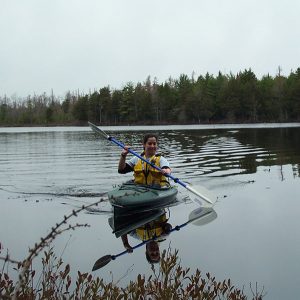Mitchell Center Researcher Completes EPA Report Compiling 30 Years of Lake Sampling
 Mitchell Center researcher Sarah Nelson recently completed a report that brings together data spanning 30 years of sampling at a set of 31 of the U.S. Environmental Protections Agency’s Long Term Monitoring Network lakes (called TIME lakes). The lakes were originally part of EMAP, the EPA’s Environmental Monitoring and Assessment Program. These lakes are sensitive to acidic deposition, and they span a broad range of landscape settings and disturbance histories. As lakefront property has become more thickly-settled by seasonal and year-round homes, and urban areas have grown more congested, some lakes have also become sentinels of human stressors across the region. Other lakes have become less human-affected: forests in New England’s more rural areas are now more continuous than during the 19th Century. Climate change exerts additional pressure across the region, and with their long-term data record, these lakes may serve as a template for predicting the effects of these changes on freshwaters in the region. An evolving program, TIME now characterizes surface waters across the region in response to landscape and temporal change, with current research projects leveraging the base monitoring program to evaluate climate change effects on surface waters, and mercury in northeastern ecosystems.
Mitchell Center researcher Sarah Nelson recently completed a report that brings together data spanning 30 years of sampling at a set of 31 of the U.S. Environmental Protections Agency’s Long Term Monitoring Network lakes (called TIME lakes). The lakes were originally part of EMAP, the EPA’s Environmental Monitoring and Assessment Program. These lakes are sensitive to acidic deposition, and they span a broad range of landscape settings and disturbance histories. As lakefront property has become more thickly-settled by seasonal and year-round homes, and urban areas have grown more congested, some lakes have also become sentinels of human stressors across the region. Other lakes have become less human-affected: forests in New England’s more rural areas are now more continuous than during the 19th Century. Climate change exerts additional pressure across the region, and with their long-term data record, these lakes may serve as a template for predicting the effects of these changes on freshwaters in the region. An evolving program, TIME now characterizes surface waters across the region in response to landscape and temporal change, with current research projects leveraging the base monitoring program to evaluate climate change effects on surface waters, and mercury in northeastern ecosystems.
Taken together, the TIME lakes provide a picture of response to acidic deposition across the Northeast. They also illustrate the wide variability in lakes across the region: from tiny remote ponds to large, crowded lakes with beaches and speedboats. With more than 20 years of data collected under the guidance of EPA, the lakes represent a long-term record sampled at a regional scale. Although some features of a lake or watershed may limit interpretation of patterns in their geochemistry or response to a specific stressor, those lakes provide information about other concurrent stressors.
Contributors were Adam J. Baumann, University of New Hampshire; Alesha Coffin, University of Maine student; Ken Johnson, Husson University; Catherine Schmitt, Maine Sea Grant; and Kristin Strock, University of Maine. The project was funded by US EPA-CAMD (Clean Air Markets Division).
